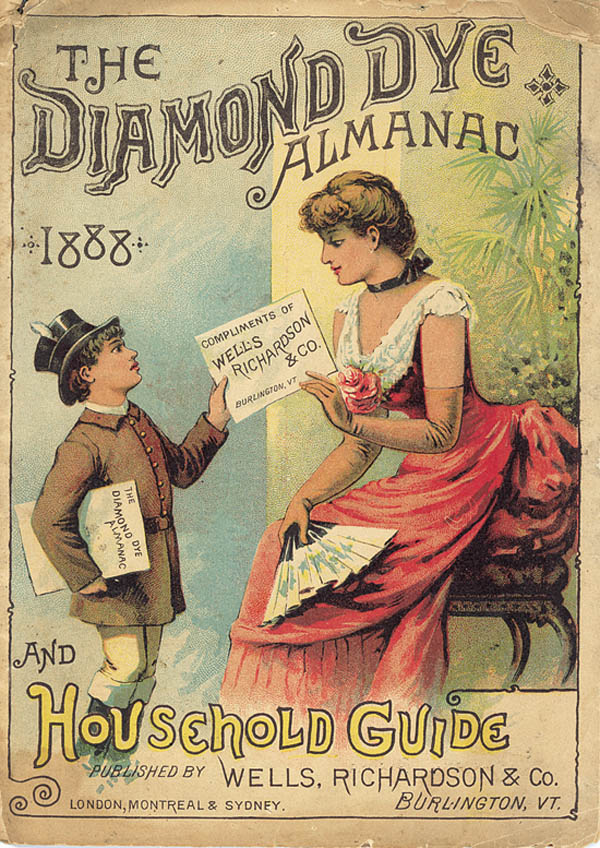Diamond Dyes Were Once A Woman's Best Friend
The use of dyes for these purposes was widespread before World War II. We can hardly envision these days just how relatively poor most Americans were before that war unleashed the flood of prosperity that still floats our many boats, though too many Americans are barely treading water. To put this in context, in 1901 hourly wages ranged from $0.17 to $0.28 while butter cost $0.27 a pound and eggs $0.22 a dozen. Consumer staples thus cost around five times more relative to what they do today. Moreover, most families' entire budgets went for staples. They were not supporting cell phones, cable TV, or paying private-school or college tuitions. Homemakers, these booklets were aimed almost exclusively at women, could rarely find even a few extra dollars to purchase new clothing or update their home decors. Dyes permitted cheap annual refurbishments.
Diamond Dye, part of Wells, Richardson & Co. of Burlington, Vt., had a national presence by the 1880s documented by almanacs and booklets. In 1885 Wells issued a series of almanacs bearing the names of different states. I have copies imprinted Massachusetts, New York, Pennsylvania, and Vermont. Their front covers are identical except for the state name and Capitol building. The back covers are identical ads for Diamond dyes. The Diamond Dye Almanac appeared in 1888. Two booklets from that decade, Cousin John's Extravagant Wife and Class in Economy, turn up more often on Ebay than Diamond's later booklets. Cousin John, a story by Emily Hayes preaching economy, is the only Diamond booklet owned by many libraries (most Diamond booklets do not show up at all on Worldcat, the database accumulating all important libraries' collections.) Cousin John has the same back cover as Class in Economy. (There is also an abridged, black-and-white edition of Cousin John.) Both devote many of their pages to Wells' patent medicines, addressing kidney ailments, malaria, constipation, and much else, advertising that is absent from Diamond's 20th-century booklets. How Claire and I Dyed also advertised those patent medicines, but, in addition, devoted its back cover and eight inside pages to Wells' other major product line, Lactated Foods, a milk-based product for infants and invalids. Lactated Food, with testimonials dated 1886 and covers like trade cards, devotes five pages to Diamond dyes.
Diamond's gorgeous plaid-pattern booklet of 1892 is larger and more comprehensive than its predecessors. Its 32 pages, plus covers, listed dyes for many home uses, including Easter eggs and flowers; described dyeing processes; explained color mixing; promised that consumers, both male and female, could make more money at home dyeing than they did working in mills; devoted several pages to making inks; and offered valuable information on many topics. A Modern Cinderella, circa 1890s, showcases both practical and artistic uses of Diamond dyes. Wells' American Bird Pictures In Colored Crayons (1899) provided line drawings of 14 bird species to be filled in with designated dye colors, an early paint by numbers. Available birds included the flamingo and the California woodpecker. That same year a beautiful booklet informed women How to Dress Well at Small Expense. Wells even plugged its dyes on the back cover of its impressive Virginia Album, which is filled with testimonials for its Paine's Celery Compound from celebrated Americans, including President McKinley. The charming Nursery Rhymes Pictorial, with a fine wrap-around cover, is undated but falls stylistically in the 1890s.
My favorite Diamond booklet is The Modern Witch and Her Magic. The title is offensive, but the cover is rich Art Nouveau. It offered consumers the American Bird Pictures book, plus a set of ten Diamond Dye Crayons in return for two 2-cent stamps, more evidence of the cheapness of that era, so it probably appeared at the turn of the 20th century. Women could create mix-and-match wardrobes. The title page states: "Cut across each page, having dress pattern, along the dotted line and get thirty-two new dresses by combining the different waists with the different skirts." It then offered a set of ten Diamond Dye crayons to color the dress designs in return for two 2-cent stamps (meaning that in the American Bird Pictures offer, the booklet was in fact free).
Diamond booklets from the first decade of the 20th century spice up any collection of books or ephemera. Both the front and back covers of the 1901 booklet declaring that Diamond dyes "have all the colors of the rainbow" are striking examples of design and the printing arts of the day. It is larger physically than the other 1900s booklets I name, measuring almost 8.5-by-6-inches versus 5-by-4-inches or smaller. Besides providing information of many kinds, illustrations, testimonials, and the usual materials, it offered three free books: Animal and Bird Pictures, Rug Patterns, and Artistic Uses of Ribbons in return for 2-cent stamps (the animal book offer included crayons and cost two stamps). A Tale of Four Children Merry & Wise (1905) contains a long poem and four full-page color pictures showing Misses Winter, Spring, Summer, and Autumn. The back cover is an exquisite Art Nouveau calendar. The only ad in this booklet is a small plug for the Diamond Dye Annual, which Wells would send to consumers free, along with "45 pieces of dyed cloth (different shades)" just for sending their name and address. The most topically collectible Diamond booklet A Teddy-Bear Tale appeared in 1907. It has a colorful two-page centerfold of bears, two other full-page color bear pictures, and a 1907 calendar on the back cover. Some Little Tots and Diamond Dyes (1908), with verses by M. G. Hays and illustrations by G. G. Wiederseim, also has four full-page color illustrations.
As these books noted, Diamond's marketing effort had by then mostly shifted to its Diamond Dye Annuals. I possess numbers 3, 5, 6, 7, 8, 9, 11, 12, 13, 14, and 15. I have had a standing Ebay search for this title for several years and few ever show up, so it is safe to assume that they are scarce, if not rare. Only six copies are reported on Worldcat, the earliest being 1911. I will only discuss two issues: 1909-10, the last with a monochromatic cover, and 1917-18, the latest I have seen (at number 11 its title changed to The Diamond Dye Annual and Direction Book). The meat of the 1909 issue is 12 large black-and-white illustrations of women and girls engaged in activities ranging from tennis and golf to teas and musicales. The text pages contain the same kinds of information as was usual in Diamond publications. The 1917 issue, number 15, is illustrated with photographs rather than the earlier line drawings, eight large and several small. Photographs had replaced drawings in the annuals the year before. The large photos are the same in both years. The most unexpected feature in this volume is a page giving very brief descriptions of the use of dyes in Italian, Spanish, Polish, Bohemian, Russian, and Yiddish. A review of earlier editions found the same page in number 13, and, more surprisingly, longer descriptions in Yiddish, Spanish, Polish, and Bohemian in number 12, 1914-15.
So it seems that Diamond publications could appeal to collectors of many kinds of ephemera. Moreover, although they are quite scarce, they sell for next to nothing when they do show up on Ebay. The very day I write this, I won a second copy of 1909-10 for $3, plus $1.25 shipping. I will no longer be pursuing these prizes, and I will be giving them, as I do when I finish working on an area to the Winterthur Library in Wilmington, Del. I encourage readers to take my place scooping up these artistic and historical treasures before others begin finally to appreciate their glories.














